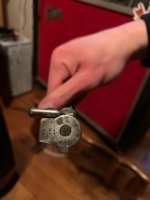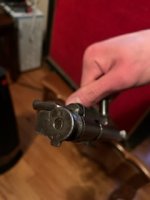ajczarkowski
Member
*Update as of 03/23/2024*
I believe I’ve narrowed down the issue to the nut on the back of the bolt that that firing pin screws into. It does not seem to have been threaded properly…
There is not enough thread on it to finish a final rotation of that nut. When I forced it, which involved hitting it with a hammer, I could get that last rotation but the cocking piece would get caught causing the slow movement and light strikes.
I ordered a “new” nut, but until then I simply put the nut on with one less rotation. The firing pin seems to move forward a lot snappier now.
————————
Hi everybody! I'm new to this forum and this is my first post, I believe I am posting it in the right section but apologize in advance if it is not. I am a big history buff and am excited to have discovered this forum!
Although technically not a Mauser rifle, I have a question pertaining to a Gewehr 88/05 that I picked up last winter.
Cosmetically it is in great shape. After inspecting it and determining it seemed to be in good enough shape to be fired, I brought it to the range. I fired maybe 40 rounds or so through it... first of all I have to say it was a really fun old rifle to shoot! There were substantial light primer strikes, however. I want to say about 1 out of 5 were light strikes. I figured the mainspring is probably the original that was manufactured in 1890. So, I went to Myers Arms' website and purchased a new one. I have no idea when the last time the bolt was disassembled, but it was absolute hell to get it apart. The nut on the back was extremely tight - I actually needed a heavy duty screw driver to help turn the thing (by putting the flathead between the metal tab on the side and the bolt body). After getting it disassembled, I found there was a lot of grease on the parts... I admit I probably should have done a better job of cleaning it up while it was disassembled. I installed the new mainspring and got it reassembled.
Then I took it to the range a second time. To my surprise, nearly all the attempts to fire were now light strikes! I want to say now 9/10 times I attempt to fire it results in light strikes. The firing pin is making really good indentations on the primers, but it actually seems to be moving forward very slowly compared to another Gewehr 88 rifle. I would also like to note that I don't believe the ammo is an issue - as my buddies and I used the same two lots of 8mm ammo in another Gewehr 88, and it worked 100% reliably in the other one.
I admit that while I have been shooting guns since I was a kid, I am not super familiar with some of the more technical aspects. Any advice on how I should proceed would be greatly appreciated! I would love to get this old antique working reliably again!
Thank you all in advance!
I believe I’ve narrowed down the issue to the nut on the back of the bolt that that firing pin screws into. It does not seem to have been threaded properly…
There is not enough thread on it to finish a final rotation of that nut. When I forced it, which involved hitting it with a hammer, I could get that last rotation but the cocking piece would get caught causing the slow movement and light strikes.
I ordered a “new” nut, but until then I simply put the nut on with one less rotation. The firing pin seems to move forward a lot snappier now.
————————
Hi everybody! I'm new to this forum and this is my first post, I believe I am posting it in the right section but apologize in advance if it is not. I am a big history buff and am excited to have discovered this forum!
Although technically not a Mauser rifle, I have a question pertaining to a Gewehr 88/05 that I picked up last winter.
Cosmetically it is in great shape. After inspecting it and determining it seemed to be in good enough shape to be fired, I brought it to the range. I fired maybe 40 rounds or so through it... first of all I have to say it was a really fun old rifle to shoot! There were substantial light primer strikes, however. I want to say about 1 out of 5 were light strikes. I figured the mainspring is probably the original that was manufactured in 1890. So, I went to Myers Arms' website and purchased a new one. I have no idea when the last time the bolt was disassembled, but it was absolute hell to get it apart. The nut on the back was extremely tight - I actually needed a heavy duty screw driver to help turn the thing (by putting the flathead between the metal tab on the side and the bolt body). After getting it disassembled, I found there was a lot of grease on the parts... I admit I probably should have done a better job of cleaning it up while it was disassembled. I installed the new mainspring and got it reassembled.
Then I took it to the range a second time. To my surprise, nearly all the attempts to fire were now light strikes! I want to say now 9/10 times I attempt to fire it results in light strikes. The firing pin is making really good indentations on the primers, but it actually seems to be moving forward very slowly compared to another Gewehr 88 rifle. I would also like to note that I don't believe the ammo is an issue - as my buddies and I used the same two lots of 8mm ammo in another Gewehr 88, and it worked 100% reliably in the other one.
I admit that while I have been shooting guns since I was a kid, I am not super familiar with some of the more technical aspects. Any advice on how I should proceed would be greatly appreciated! I would love to get this old antique working reliably again!
Thank you all in advance!
Last edited:









